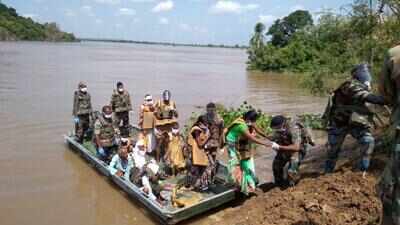
Nagpur: The sudden floods have raised questions over coordination between authorities in Madhya Pradesh and Maharashtra. Former chief minister Devendra Fadnavis has also raised the issue. Water released from Chaurai dam in Chhindwara district in Madhya Pradesh flooded the Pench river in Maharashtra. This had a cascading effect on Wainganga river further eastwards, covering Bhandara, Chandrapur and Gadchiroli.
Chaurai dam was 80% full in July itself and MP government should have begun releasing water at that time, which could have prevented the present crisis, pointed out a revenue department official here. Though the theory has also been countered by others.
Nagpur district’s guardian minister Nitin Raut countered Fadnavis saying the villagers were intimated in time but the problem arose after excessive water was released from Madhya Pradesh. The district collector Ravindra Thakare said the coordination happens between two WRDs and his department did not have any intimation from MP.
TOI talked to officials from water resources departments (WRD) of both states. They said even both were in constant touch over through whattsapp group having officials from both sides and also from Central Water Commission. Communication was maintained on real time basis but the massive downpour gave little reaction time.
A calculated risk by the Vidarbha Irrigation Development Corporation (VIDC) helped, however. VIDC decided to hold part of the discharge from MP at Totladoh dam in Maharashtra. This helped reduce the flood intensity by almost 25%.
More than 9,000 cubic metres per second (cumecs) of water being released from Chaurai dam came into Totladoh dam. An engineer in the WRD in MP said a message was put in WhatsApp group between 7 and 8 pm on Friday evening. The officer managing the disaster management cell at Nagpur’ collectorate said a message was received on Saturday morning.
“It rained 414 mm over Friday and Saturday. As the catchment area of the river is scattered, it was difficult to judge the flow of water. Water reaches the dam from seven different locations. It was so fast that there was little time react,” said an MP official.
On releasing the water in July itself when the dam was 80% full, sources said it depends on complex calculations. Even as there was an IMD warning about heavy rains, at times water is not released beforehand. “It may lead to a shortage if the prediction fails,” an officer in Maharashtra said. Sources in Madhya Pradesh accepted it.
On Maharashtra side, VIDC took a timely decision. According to the norms the entire excess water has to be released. This means as much as 9,000 cumecs of water should have been released from Totladoh. However, this could have caused a bigger loss. VIDC officials decided to hold as much as 3,000 cumecs in Totladoh. This reduced the discharge and reduced intensity considerably, said a senior official monitoring the situation.
Sources in state’s WRD said it would not be right to blame MP, as the situation was extraordinary. 414mm rain is half of the entire season’s average. Going by norms, more than 65mm downpour is seen as excessive.
Chaurai dam was 80% full in July itself and MP government should have begun releasing water at that time, which could have prevented the present crisis, pointed out a revenue department official here. Though the theory has also been countered by others.
Nagpur district’s guardian minister Nitin Raut countered Fadnavis saying the villagers were intimated in time but the problem arose after excessive water was released from Madhya Pradesh. The district collector Ravindra Thakare said the coordination happens between two WRDs and his department did not have any intimation from MP.
TOI talked to officials from water resources departments (WRD) of both states. They said even both were in constant touch over through whattsapp group having officials from both sides and also from Central Water Commission. Communication was maintained on real time basis but the massive downpour gave little reaction time.
A calculated risk by the Vidarbha Irrigation Development Corporation (VIDC) helped, however. VIDC decided to hold part of the discharge from MP at Totladoh dam in Maharashtra. This helped reduce the flood intensity by almost 25%.
More than 9,000 cubic metres per second (cumecs) of water being released from Chaurai dam came into Totladoh dam. An engineer in the WRD in MP said a message was put in WhatsApp group between 7 and 8 pm on Friday evening. The officer managing the disaster management cell at Nagpur’ collectorate said a message was received on Saturday morning.
“It rained 414 mm over Friday and Saturday. As the catchment area of the river is scattered, it was difficult to judge the flow of water. Water reaches the dam from seven different locations. It was so fast that there was little time react,” said an MP official.
On releasing the water in July itself when the dam was 80% full, sources said it depends on complex calculations. Even as there was an IMD warning about heavy rains, at times water is not released beforehand. “It may lead to a shortage if the prediction fails,” an officer in Maharashtra said. Sources in Madhya Pradesh accepted it.
On Maharashtra side, VIDC took a timely decision. According to the norms the entire excess water has to be released. This means as much as 9,000 cumecs of water should have been released from Totladoh. However, this could have caused a bigger loss. VIDC officials decided to hold as much as 3,000 cumecs in Totladoh. This reduced the discharge and reduced intensity considerably, said a senior official monitoring the situation.
Sources in state’s WRD said it would not be right to blame MP, as the situation was extraordinary. 414mm rain is half of the entire season’s average. Going by norms, more than 65mm downpour is seen as excessive.

Coronavirus outbreak
Trending Topics
LATEST VIDEOS
City
 Maharashtra: 3 cops dismissed from service in Palghar lynching case
Maharashtra: 3 cops dismissed from service in Palghar lynching case  Fresh India-China face-off in Ladakh: Srinagar-Leh highway closed for civilians
Fresh India-China face-off in Ladakh: Srinagar-Leh highway closed for civilians  SSR death probe: Dean of Cooper Hospital quizzed with regards to Rhea Chakraborty’s entry in mortuary
SSR death probe: Dean of Cooper Hospital quizzed with regards to Rhea Chakraborty’s entry in mortuary  Decline in medical condition of former President Pranab Mukherjee: Army hospital
Decline in medical condition of former President Pranab Mukherjee: Army hospital
More from TOI
Navbharat Times
Featured Today in Travel
Quick Links
Kerala Coronavirus Helpline NumberHaryana Coronavirus Helpline NumberUP Coronavirus Helpline NumberBareilly NewsBhopal NewsCoronavirus in DelhiCoronavirus in HyderabadCoronavirus in IndiaCoronavirus symptomsCoronavirusRajasthan Coronavirus Helpline NumberAditya ThackerayShiv SenaFire in MumbaiAP Coronavirus Helpline NumberArvind KejriwalJammu Kashmir Coronavirus Helpline NumberSrinagar encounter
Get the app



